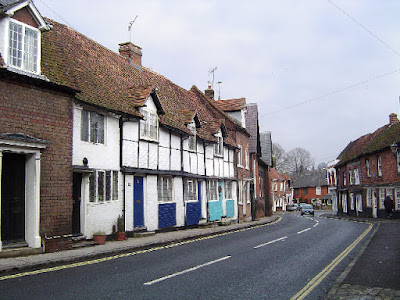Some of the best crime series on TV are those filmed in
scenic parts of the country: Vera (ITV) showcases the windswept landscapes of
Northumberland and the gritty streets of Newcastle; Inspector Morse and its
spinoffs Endeavour and Lewis (ITV) take us on a tour of the venerable streets
and colleges of Oxford; and Shetland (BBC) speaks for itself. These are just
three examples among many. In McDonald
and Dodds, screened on ITV over three seasons, we are transported to the regency
elegance of Bath and surrounding areas, as we follow the intricate caseloads
of “down from London” DCI Lauren McDonald
(Tala Gouveia) and her new sidekick the drearily old-fashioned (but brilliant) DS
Dodds (Jason Watkins).
We are shown some lovely aerial shots of the city, with two
of the most famous landmarks standing out: the Royal Crescent and Pulteney Bridge. Parade Gardens, near the weir
below Pulteney Bridge, is where Dodds has a chat with Max Crockett (Robert
Lindsay) in The Fall of the House of Crockett (season 1, episode 1), and also
features in The War of Rose (season 2, episode 3), in which McDonald and Dodds
are seen discussing the case of a murdered vlogger in the gardens, with Bath Abbey looming majestically in the background.
In A Wilderness of Mirrors (season 1, episode 2), featuring an addiction treatment retreat, we
are given a brief glimpse of the interior of a Bath institution, The Bell Inn on
Walcote Street, a watering hole famous for its live music. Queen Square makes several appearances in the
series showing people playing boules.
 |
| Pulteney Bridge |
The countryside around Bath is studded with stunning properties,
and some of these were used as locations in the series. The Crockett household in The Fall of the
House of Crockett is Crowe Hall in real life, a grade II listed Georgian
mansion in Widcombe, to the east of the city centre heading out towards the
University. Eastwood Park near Wotton-under-Edge in nearby
Gloucestershire was used as the Mara Retreat in The Wilderness of Mirrors. Other landmarks near the city used in the
series include the Box Tunnel, where a murder takes place in We Need To Talk
About Doreen (season 2, episode 2), and Dundas Aqueduct where the dramatic
final scene of Clouds Across the Moon (last episode of series 3) was
filmed. In some scenes from Clouds
Across the Moon we are taken further afield to the mystical town of Glastonbury
and its famous Tor.
 |
| Eastwood Park, Falfield - geograph.org.uk - 379225. Photo by Peter Wasp, via Wikimedia Commons. |
The Royal Crescent in Bath was started in 1767
and consists of 30 Grade I listed terrace houses, including the
city’s most luxurious hotel. The
construction of Pulteney Bridge, designed by Robert Adam in the Palladian style,
began in 1769, intended as a link between the city and land owned by the
Pulteney family. There is a small charge
to enter Parade Gardens, which provide a pleasant riverside oasis within the
city. There is no charge to enter Bath
Abbey, but donations are encouraged. Queen
Square, surrounded by elegant Georgian houses, was opened in 1728. As in the series, in real life the square is
used for playing boules, and is the venue for the annual Bath Boules tournament
held in July.
The gardens of Crowe Hall are open to the
public several times a year for a small entrance charge. Eastwood Park, near the M5 to the north of
Bristol, is a conference and wedding venue.
The Park consists of a large Victorian house surrounded by 200 acres of
countryside. The Box Tunnel, opened in
1841, cuts through Box Hill on the railway line between Bath and
Chippenham. At the time of building the tunnel was claimed to be the longest railway tunnel ever built. The Dundas Aqueduct, which
opened in 1805, carries the Kennet and Avon Canal over the River Avon and the
railway line between Bath and Westbury. The
town of Glastonbury has a unique atmosphere due to the many “new age” style
shops and attendant eccentrics such as self-styled wizards and other spiritual
types. It is reputed to be the burial
place of King Arthur, and to have been a site of Pre-Christian worship. The tor, topped by St Michaels Tower, commands
splendid views over the surrounding Somerset Levels. The tor can often be glimpsed in shots of the
Glastonbury Festival, which takes place near the village of Pilton, some
distance away.
 |
| Glastonbury Tor from north east showing terraces 2. Photo by Rodw, via Wikimedia Commons. |
Map of Bath.










.jpg)

.jpg)







